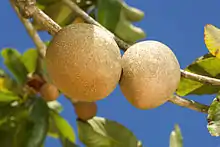Pouteria sapota
Pouteria sapota, the mamey sapote, is a species of tree native to Mexico and Central America. The tree is also cultivated in the Caribbean. Its fruit is eaten in many Latin American countries. The fruit is made into foods such as milkshakes and ice cream.
| Mamey sapote | |
|---|---|
 | |
| Scientific classification | |
| Kingdom: | Plantae |
| Clade: | Tracheophytes |
| Clade: | Angiosperms |
| Clade: | Eudicots |
| Clade: | Asterids |
| Order: | Ericales |
| Family: | Sapotaceae |
| Genus: | Pouteria |
| Species: | P. sapota |
| Binomial name | |
| Pouteria sapota | |
| Synonyms[2] | |
| Nutritional value per 100 g (3.5 oz) | |
|---|---|
32.1 g | |
| Sugars | 20.14 g |
| Dietary fiber | 5.4 g |
0.46 g | |
1.45 g | |
| Vitamins | Quantity %DV† |
| Thiamine (B1) | 1% 0.013 mg |
| Riboflavin (B2) | 10% 0.116 mg |
| Niacin (B3) | 10% 1.432 mg |
| Pantothenic acid (B5) | 8% 0.397 mg |
| Vitamin B6 | 55% 0.72 mg |
| Folate (B9) | 2% 7 μg |
| Vitamin C | 28% 23 mg |
| Vitamin E | 14% 2.11 mg |
| Minerals | Quantity %DV† |
| Calcium | 2% 18 mg |
| Iron | 6% 0.78 mg |
| Magnesium | 3% 11 mg |
| Manganese | 10% 0.204 mg |
| Phosphorus | 4% 26 mg |
| Potassium | 10% 454 mg |
| Sodium | 0% 7 mg |
| Zinc | 2% 0.19 mg |
| |
| †Percentages are roughly approximated using US recommendations for adults. Source: USDA FoodData Central | |
Some of its names in Latin American countries, such as mamey colorado (Cuba), zapote colorado (Costa Rica) and zapote rojo (South America), refer to the reddish colour of its flesh to distinguish it from the unrelated but similar-looking Mammea americana, whose fruit is usually called "yellow mamey" (Spanish: mamey amarillo).
The Australian and Queensland governments' research and development programs have grown mamey sapote in Australia.
Description
Mamey sapote is a large and highly ornamental evergreen tree that can reach a height of 15 to 45 m (49 to 148 ft) at maturity.[3] It is mainly propagated by grafting, which ensures the new plant has the same characteristics as the parent, especially its fruit, as it does not grow true to seed. It is also considerably faster than growing trees by seed, producing fruit in 3–5 years; trees grown from seed require 7 years of growth before fruiting.[4] In Florida, the fruit is harvested from May to July with some cultivars available all year.[5][6]
The fruit, technically a berry,[7] is about 10 to 25 cm (4 to 10 in) long and 8 to 12 cm (3 to 4.5 in) wide and has flesh ranging in color from pink to orange to red. The brown skin has a texture somewhat between sandpaper and the fuzz on a peach.[8] The fruit's texture is creamy and soft, and the flavor is a mix of sweet potato, pumpkin, honey, prune, peach, apricot, cantaloupe, cherry, and almond.[9][10][11] A mamey sapote is ripe when the flesh is vibrant salmon in color when a fleck of the skin is removed.[12] The flesh should give slightly, as with an overripe avocado. The leaves are pointed at both ends, 4 to 12 inches in length, and grow in clusters at the ends of branches.[13]
The mamey sapote is related to other sapotes such as sapodilla (Manilkara zapota), abiu (P. caimito), and canistel (P. campechiana), but unrelated to the black sapote (Diospyros digyna)[14] and white sapote (Casimiroa edulis).[15][16][17]
 Leaves on tree
Leaves on tree Fruit on branch
Fruit on branch Fruit flesh and kernel
Fruit flesh and kernel Mamey at a Tepoztlan market
Mamey at a Tepoztlan market Tree bark
Tree bark Branch with young fruit
Branch with young fruit
Uses
The fruit is eaten raw or made into milkshakes, smoothies, ice cream, and fruit bars. It can be used to produce marmalade and jelly.[18] It can also be fried like bacon. Some beauty products use oil pressed from the seed,[19] otherwise known as sapayul oil.[20]
Nutrition

The fruit is an excellent source of vitamins B6 and C, and is a good source of riboflavin, niacin, vitamin E, manganese, potassium, and dietary fiber. Research has identified several new carotenoids from the ripe fruit.[21][22]
Synonyms[2]
- Achras mammosa Bonpl. ex Miq. nom. illeg.
- Achras zapota var. major Jacq.
- Bassia jussaei Griseb.
- Bassia jussiaei Tussac
- Calocarpum huastecanum Gilly
- Calocarpum mammosum var. bonplandii (Kunth) Pierre
- Calocarpum mammosum var. candollei (Pierre) Pierre
- Calocarpum mammosum var. ovoideum (Pierre) Pierre
- Calocarpum sapota (Jacq.) Merr.
- Calospermum mammosum var. bonplandii (Kunth) Pierre
- Calospermum mammosum var. candollei Pierre
- Calospermum mammosum var. ovoidea Pierre
- Calospermum parvum Pierre
- Lucuma bonplandiiv Kunth
- Sapota mammosa Mill.
- Sideroxylon sapota Jacq.
- Sideroxylum sapota Jacq.
See also
- Lucuma
- Mammea americana (mamey apple)
- Sapodilla
References
- Botanic Gardens Conservation International (BGCI) & IUCN SSC Global Tree Specialist Group (2021). "Pouteria sapota". IUCN Red List of Threatened Species. 2021: e.T150102002A150108560. doi:10.2305/IUCN.UK.2021-1.RLTS.T150102002A150108560.en. Retrieved 25 March 2022.
- "The Plant List".
- Morton, Julia 1987. Sapote. p. 398–402. In: Fruits of warm climates. Julia F. Morton, Miami, FL. at Center for New Crops & Plant Products, at Purdue University
- CULTIVATION OF MAMEY SAPOTE AND GREEN SAPOTE - The Rare Fruit Council of Australia
- "Mamey Sapote - Florida Department of Agriculture and Consumer Services". Archived from the original on 2017-11-19. Retrieved 2016-01-28.
- Mamey Sapote - Melissa's Produce
- Mamey Sapote - CooksInfo.com
- The Tropical Fruit Growers present - Mamey Sapote
- "Mamey Sapote Exotic Tropical Fruit - Cape Tribulation". Archived from the original on 2016-11-13. Retrieved 2016-01-28.
- Mamey – A Tropical Miami Fruit That Should Become Mainstream - Forbes
- "Mamey Sapote - LocalHarvest". Archived from the original on 2018-02-22. Retrieved 2016-01-28.
- Fruit of the Month: Mamey Sapote
- Introducing the mamey | Alain Dubernard | Restaurant Business
- Good Enough To Eat: Soft fruits: The names and tastes vary - Seattle Post-Intelligencer
- Boning, Charles R. (2006). Florida's Best Fruiting Plants: Native and Exotic Trees, Shrubs, and Vines. Sarasota, Florida: Pineapple Press, Inc. p. 139. ISBN 978-1561643721.
- Florida Crop/Pest Management Profile: Mamey Sapote and Sapodilla
- MAMEY SAPOTE (Pouteria sapote) - fruitipedia
- Jamieson, G. S.; McKinney, R. S. (1931). "Sapote (mammy apple) seed and oil". Oil & Fat Industries. 8 (7): 255–256. doi:10.1007/BF02574575. S2CID 101373525.
- Molly Chadwick (11 January 2011). "Emerald Forest® Botanical Hair Care With Rainforest Sapayul Commits to More Natural Products With Introduction of Paraben Free Shampoos And Conditioners". Encinitas, CA: PRWEB. Retrieved 29 August 2014.
Sapayul oil comes from the seeds of sapote, a fruit indigenous to the Central American rainforests and an ancient Mayan secret for beautiful, soft, and shiny hair.
- Anita Grant (14 December 2006). "Organic Sapote Seed Oil (inci: Pouteria Sapota, Zapote, Mamey Sapote, Zapayul, Sapayul)". anitagrant.com's photostream. Flickr. Retrieved 25 August 2011.
Organic Sapote Seed Oil (inci: Pouteria Sapota, Zapote, Mamey Sapote, Zapayul, Sapayul)
The seed is used on the Caribbean island of Grenada as a flavoring for cakes. - Murillo E, McLean R, Britton G, Agócs A, Nagy V, Deli J (2011). "Sapotexanthin, an A-provitamin carotenoid from red mamey (Pouteria sapota)". J Nat Prod. 74 (2): 283–5. doi:10.1021/np1006982. PMID 21214217.
- Gulyás-Fekete G, Murillo E, Kurtán T, Papp T, Illyés TZ, Drahos L, Visy J, Agócs A, Turcsi E, Deli J (2013). "Cryptocapsinepoxide-Type Carotenoids from Red Mamey, Pouteria sapota" (PDF). J Nat Prod. 76 (4): 607–14. doi:10.1021/np3007827. PMID 23451823.
External links
 Media related to Pouteria sapota at Wikimedia Commons
Media related to Pouteria sapota at Wikimedia Commons- New Crop Resource Online Program: Sapote
